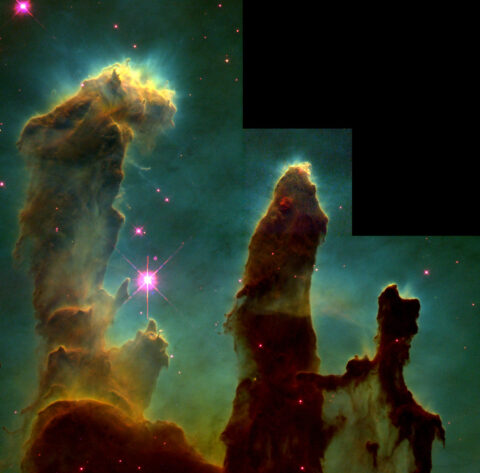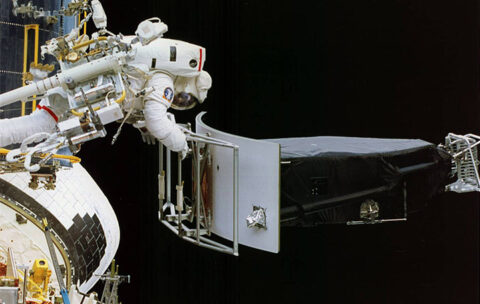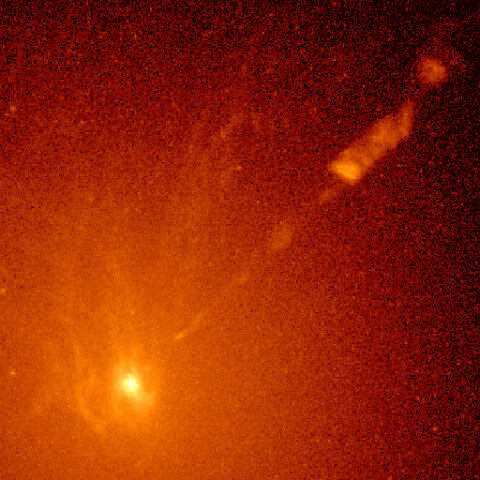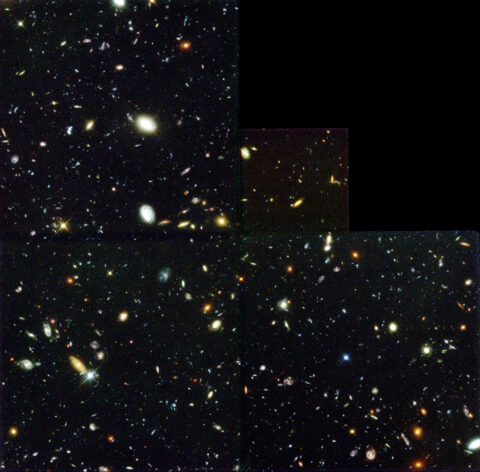On 24 April 1990, the space shuttle Discovery rumbled into space carrying a school bus–sized payload: the largest astronomical telescope ever to fly above the haze of Earth’s atmosphere.

Named for Edwin Hubble, the American astronomer who proved that the universe is expanding and that there are galaxies beyond ours, the Hubble Space Telescope has peered deeper into space and with greater clarity than any telescope before it.
Its images have given astronomers the first photo album of galaxies, charting their evolution from surprisingly massive blobs in the infant universe to the majestic spiral and elliptical galaxies of today. Hubble, funded by NASA and the European Space Agency, has pinned down the age of the universe and discovered compelling evidence for the existence of supermassive black holes. The telescope’s observations of distant exploding stars helped convince astronomers that the universe is being ripped apart, expanding at an ever-faster rate. That accelerated expansion has been called one of the greatest mysteries in all of physics.
Closer to home, Hubble has examined the atmospheres of alien worlds that lie relatively nearby—planets orbiting stars from a few tens to a few hundreds of light-years from the Sun. It has also given new insight into the processes that govern the formation and evolution of our own solar system.
Hubble is the most important piece of scientific hardware that’s ever been built by humans.
“Hubble is the most important piece of scientific hardware that’s ever been built by humans and has returned more scientific information about the physical world than any other device in human history,” says astronaut Drew Feustel, who helped repair and upgrade Hubble during the observatory’s final servicing mission in 2009.
Hubble is also a story of bouncing back from catastrophic failures, according to Robert Williams, an astronomer and former director of the Space Telescope Science Institute (STScI) in Baltimore, Md., which operates Hubble. First, astronomers had to find a way for the telescope to recover from its notoriously flawed primary mirror, which blurred the vision of the observatory, causing some people to brand the $1.6 billion telescope a “techno-turkey.” A decade later, the telescope got another death sentence: On the heels of the Columbia space shuttle disaster on 1 February 2003, a NASA administrator declared that it was too dangerous to allow another shuttle mission to ever service Hubble.
Failure and redemption, breathtaking images, and a demonstration of humankind’s ability to work in space—“all of these factors working together” have made Hubble a cultural icon, says Williams.
Early Days
Hubble’s roots go back to 1946—12 years before NASA was founded—when astronomer Lyman Spitzer suggested that scientists build, launch, and operate an observatory in space. Flying above Earth’s atmosphere solves a problem that has plagued astronomers since the time of Galileo: As the pristine light from stars and galaxies travels through our planet’s atmosphere, it becomes distorted by the layers of turbulent gases, limiting the ability of telescopes on the ground to produce clear images. The atmosphere also blocks or obscures several bands of wavelengths in the electromagnetic spectrum, including those in the ultraviolet, preventing ground-based telescopes from making a full portrait of the cosmos.
Spitzer’s idea for a space telescope didn’t take off until 1962, when the U.S. National Academy of Sciences recommended that NASA begin planning for a large orbiting observatory.
The telescope was finally ready for launch by the mid-1980s, but the explosion of the space shuttle Challenger during liftoff on 28 January 1986 delayed the telescope’s debut. At the time of its launch in 1990, Hubble carried equipment that had been built in the 1970s.

Two months after Hubble entered orbit, NASA discovered that the observatory’s 2.4-meter-wide mirror was misshapen, with its outer edge ground too flat by 4 micrometers, about one fiftieth the diameter of a human hair. The tiny flaw was enough to blur the observatory’s image: Only the central 20% of each picture was in focus. Hubble and NASA became objects of ridicule.
By December 1993, when NASA launched a space shuttle mission to fix the telescope, blurry vision was only one of Hubble’s problems. Failing gyroscopes prevented the observatory from staying fixed on celestial targets. In addition, the transition from searing sunlight to frigid darkness during each 90-minute Earth orbit had caused the telescope’s aging solar arrays to oscillate, literally giving the observatory a case of the jitters.
“The situation was terrible,” recalls former astronaut Jeffrey Hoffman, now a professor at the Massachusetts Institute of Technology (MIT).
Among other tasks, Hoffman and a crew of five other astronauts inserted tiny corrective mirrors in front of the observatory’s detectors, exactly compensating for Hubble’s misshapen mirror.
Three weeks after the mission to correct the lens ended, on New Year’s Eve 1993, Hoffman received a call from a senior STScI official. After wishing Hoffman a happy new year, the official asked Hoffman if he had a bottle of champagne handy. Images had just come down from the refurbished Hubble, he told Hoffman, and they were crystal clear.
First Compelling Evidence for Supermassive Black Holes

Astronomers immediately began reaping the benefits of the repaired Hubble. With Hubble’s Faint Object Spectrograph, Holland Ford of Johns Hopkins University and his colleagues homed in on the suspected site of a supermassive black hole: the center of the giant elliptical galaxy M87, some 50 million light-years from Earth. The team clocked the speed at which a disk of hot gas near the galaxy’s center whipped around the core.
The speed of the gas, about 550 kilometers per second, along with its central location, suggested that the spinning disk was being tugged by a massive, compact object—an object as heavy as 3 billion suns confined to a region no larger than our solar system. Only a supermassive black hole, an object whose gravity is so strong that not even light can escape its grasp, could fill the bill, the researchers concluded.
The finding was the first definitive confirmation for the existence of a giant black hole beyond the Milky Way galaxy. Soon Hubble, along with other telescopes, would find that the core of nearly every large galaxy houses such a gravitational beast. Hubble observations also showed that monster black holes grow in lockstep with the central distribution of stars in their home galaxy. Astronomers speculate that the jets and winds associated with black holes disrupt or expel star-forming gas, regulating galaxy growth.
A Comet Hits Jupiter
One of Hubble’s earliest claims to fame came from observations in our own solar system.
In 1993, planetary scientists Gene and Carolyn Shoemaker and amateur astronomer David Levy discovered a comet called Shoemaker-Levy 9, which had been torn into pieces by a close gravitational encounter with Jupiter. Studies of the comet’s orbit revealed that in July 1994, the fragments would smash into the gas giant.

At MIT, planetary scientist Heidi Hammel was unimpressed when a graduate student breathlessly relayed the news. “My reaction was ‘Oh, please; Jupiter is huge, comets are tiny; nothing is going to happen.’”
Nonetheless, when a colleague calculated that the collisions could create dark plumes big enough to be seen in Jupiter’s atmosphere, Hammel agreed to write a proposal to request Hubble time. Only a few weeks later, a still skeptical Hammel was told not only that her proposal was accepted but that she would coordinate other Hubble observations of the weeklong event.
At a press conference at STScI on 16 July, the Shoemakers and Levy were cautioning reporters that there might not be much to see. In the basement, huddled around a computer screen, Hammel; Melissa McGrath, a planetary scientist then working at STScI; and other planetary scientists scrutinized Hubble images of Jupiter as they were relayed to Earth.
One of the first pictures showed a black dot on Jupiter. Hammel thought the mark might merely be the shadow of Jupiter’s moon Io. Then another image showed a big black plume rising above the planet.
One of the first pictures showed a black dot on Jupiter. Then another image showed a big black plume rising above the planet.
McGrath grabbed a bottle of champagne that she had brought, and Hammel hastily printed out a picture of the plume. Then they raced upstairs and interrupted the press conference. “It was so obvious that this was a major event, even on this ratty little computer printout,” says Hammel. “We had to break in.”
Gene Shoemaker stopped what he was saying while Hammel waved the photo from the podium. Then Shoemaker took a swig of champagne.
The Jovian collisions “were a sort of perfect physics experiment that normally can’t be done in astronomy and planetary science,” says Hammel. “The dark material deposited by the comet fragments [was] akin to injecting ink into the atmosphere of Jupiter and then watching it trace out the atmospheric motion of the planet.”
The impacts enabled scientists to directly measure Jupiter’s wind speeds in the planet’s troposphere and stratosphere, Hammel says. The suite of small, medium, and large explosions created by the Shoemaker-Levy 9 impacts “also provided deep insight into multimegaton catastrophes on Earth like the dinosaurs experienced, and we humans may yet experience,” adds Hammel.
An Eye on the Outer Solar System
More recently, Hubble uncovered four additional moons of Pluto (the moons Nix and Hydra in 2006 and two additional small moons in 2011 and 2012). Before Hubble’s launch, planetary scientists knew about only one moon, Pluto’s large satellite Charon. The surprising complexity of the Pluto system revealed by Hubble will be explored close up when NASA’s New Horizons mission flies past the dwarf planet this July.
The observatory also used its ultraviolet sensitivity to observe auroras on Jupiter, Saturn, and Uranus beginning in the early 1990s. Auroras, like Earth’s northern lights, are generated when energetic charged particles, racing along a planet’s magnetic field lines, crash onto a planet’s upper atmosphere and cause the gases there to fluoresce.
Although the charged particles that cause the auroras on Earth, Uranus, and Saturn come from the solar wind, those on Jupiter have a different origin. Io, Jupiter’s volcanically active moon, supplies most of the particles for the Jovian aurora. Charged particles spewed by the moon’s volcanoes become trapped by Jupiter’s magnetic field, which rotates in synchronicity with the planet. The rotating magnetic field creates strong electric fields at Jupiter’s magnetic poles, which accelerate the charged particles and generate the auroral ovals of light.
Joint observations of Saturn with Hubble and NASA’s Cassini spacecraft revealed where the auroras heat the planet’s upper atmosphere, accounting for the warmer-than-expected temperatures of the outer atmospheres of the giant planets despite their great distance from the Sun.
The Search for Exoplanets
Hubble has discerned the composition of planetary atmospheres beyond the solar system. To do that, Hubble (and other telescopes) relied on a rare alignment of parent star, planet, and the observatory. In that configuration, light from the star filters through the atmosphere of the orbiting planet before it reaches the telescope. Atoms and molecules in the planet’s atmosphere absorb specific wavelengths of light, providing a spectroscopic fingerprint for the constituents of the gases shrouding the planet.
The fingerprints are extraordinarily faint, but the observatory was the first, in 2001, to find sodium and water vapor in the atmospheres of exoplanets. Ultimately, the technique will be used to search for biomarkers—signs of life—in the atmospheres of these planets.
Expanding Views
On a more cosmic scale, a team led by Wendy Freedman of the Carnegie Observatories in Pasadena, Calif., used Hubble’s newfound acuity to determine the size and age of the universe. The team relied on Hubble to find a group of bright yellowish stars, known as Cepheid variables, in the distant galaxy M100.

Cepheid variables have a unique property, periodically expanding and contracting, which changes their brightness in a regular pattern. In fact, the rate at which they pulsate or flicker is closely linked to their intrinsic brightness: The slower they pulsate, the brighter they are. That makes Cepheid variables cosmic mile markers. By comparing their true brightness, as measured by their pulsation period, to their apparent brightness as observed in the sky, researchers could determine the distance to the galaxy in which the stars reside.
Obtaining accurate distances to ever more remote galaxies is a key to measuring the expansion rate and age of the universe. Freedman’s team ultimately determined that the universe was about 13 billion years old. Previously, astronomers had pegged the age at somewhere between 10 billion and 20 billion years, with acrimonious debate about what number was correct.
Dark Energy
Nearly a decade later, in 2001, Hubble used another type of mile marker to corroborate one of the most astonishing discoveries ever made in cosmology.

Something was causing the expansion rate of the universe to speed up. That contradicted the prevailing view that the expansion rate had been continually slowing ever since the big bang because of the mutual gravitational tug of all the objects in the cosmos.
The unexpected finding, from ground-based telescopes, relied on a type of exploding star called a type 1a supernova. Because all type 1a supernovas have about the same intrinsic brightness, their appearance in the sky can be used to gauge the distance to their home galaxy.
However, the supernovas studied appeared about 20% dimmer than would be expected if the universe was slowing its expansion. It meant, astronomers said, that cosmic expansion had recently sped up and that the space between Earth and the supernovas had stretched out much more than anticipated.
Scientists did not know what caused the revved-up expansion, but they attributed it to “dark energy”—a mysterious entity that exerts a cosmic push, counteracting the pull of ordinary gravity.
Scientists did not know what caused the revved-up expansion, but they attributed it to something they call “dark energy”—a mysterious entity that pervades the entire universe and exerts a cosmic push, counteracting the pull of ordinary gravity. Some astronomers, however, were not convinced by the data. They worried that researchers might have been fooled by cosmic dust that made the supernovas look dimmer.
But there was a way to convince the skeptics.
If dark energy proponents were correct, the expansion rate began to rev up about 5 billion years ago. Before that time, the universe was smaller, and its density was greater—large enough that gravity’s pull inward was much stronger than dark energy’s push outward. At those earlier times, therefore, gravity’s brake would have slowed down the expansion rate. In other words, before cosmic expansion sped up, there ought to have been a slowdown. Cosmic dust cannot mimic such a pattern.
Hubble found the type 1a supernovas that were distant enough to test this idea. These supernovas are so distant that the light now reaching Hubble was emitted by the explosion billions of light-years ago, revealing how the universe looked far back in time. In that early era, if the dark energy proponents were right, dark energy had not yet overwhelmed gravity’s tug and cosmic expansion was still decelerating. In charting the brightness of the nearby type 1a supernovas and the newfound, faraway ones, astronomers confirmed that the expansion rate had indeed slowed at earlier times.
The 2011 Nobel Prize in physics was awarded to three of the discoverers of dark energy: Saul Perlmutter of the Lawrence Berkeley National Laboratory in California, Brian Schmidt of the Australian National University in Weston Creek, and Adam Riess of the Johns Hopkins University in Baltimore and STScI.
Delving into the Past

Hubble’s strong suit remains its ability to peer into the extremely distant past. Like all telescopes, Hubble acts like a time machine. Because it takes time for light to journey from a distant object to Earth, telescopes record an image of a galaxy not as it appears now but as it looked long ago, when the light left that galaxy. “Astronomy is the only science in which you can witness the past,” says STScI astronomer Williams.
He ought to know. In 1995, as STScI director, he commanded Hubble to stare at a tiny, seemingly blank patch of sky for 10 days. That patch, known as the Hubble Deep Field, turned out to be chock-full of galaxies, some so distant that light left those starlit bodies when the 13.7-billion-year-old universe was only a few billion years old.
“The story of Hubble’s deep fields is really the history of the universe over the last 90 percent of its lifetime,” says STScI astronomer Jennifer Lotz.
Bucking traditional NASA policy, Williams decided to make the Deep Field data immediately available to all researchers, not just those who gathered the information. The data sharing became a new model for astronomers. “There’s much more collaboration now… and it’s much easier to get those discoveries out to the public because the information is not proprietary,” says Williams.
Now and the Future
The Hubble Deep Field spawned several other ultradeep portraits that have collectively examined the evolution of galaxies as far back in time as 700,000 years after the big bang, or about 7% of the age of the universe. Now astronomers want to go back farther, approaching what scientists call the cosmic Dark Ages—the era just before galaxies flooded the universe with light.
To do so, Lotz and her colleagues are making use of nature’s own lenses—massive clusters of galaxies whose gravity bends the path of light rays from background galaxies that lie behind the clusters. As described by Einstein’s general theory of relativity, the background light is magnified and brightened by the clusters, enabling Hubble to see distant galaxies 10 to 20 times fainter than it could otherwise detect.
The findings promise to give a sneak peak of what Hubble’s successor, the James Webb Space Telescope, will routinely accomplish with its much larger hexagonal mirror.
Selecting six “frontier fields,” each containing a massive galaxy cluster, Lotz’s team has begun peering back to earlier times and detecting smaller baby galaxies than had been possible to observe before. The findings promise to give a sneak peak of what Hubble’s successor, the James Webb Space Telescope (JWST) , will routinely accomplish with its much larger, 6.4-meter hexagonal mirror. JWST is scheduled for launch in late 2018.
An Enduring Legacy
Hubble’s enduring success stems from the ability of scientists to adapt the instrument to answer new questions, notes NASA’s Hubble project scientist Jennifer Wiseman. During five visits to the telescope between 1993 and 2009, astronauts essentially reinvented the observatory, updating it with state-of-the-art cameras and spectrographs that extended Hubble’s sight to the infrared and increased its sensitivity at ultraviolet and visible light wavelengths. The servicing missions “have kept Hubble at the forefront of astrophysics for all these years,” she says.
With the space shuttle retired, there are no planned missions to repair the telescope ever again. So the primary task of astronomers such as Ken Sembach, head of Hubble operations at STScI, is to maintain the health of the telescope long enough to examine the heavens in concert with JWST. The new telescope has only infrared capabilities, whereas Hubble primarily studies the cosmos at visible and ultraviolet wavelengths, discerning structures JWST cannot detect.
Sembach is working with engineers to keep the observatory’s electronics in the best shape possible. Although not every instrument on Hubble may still be working as time passes, “I’m very confident that we’ll be able to operate until 2020,” he says.
“The universe is not only stranger than we think; it’s stranger than we can think.”
What’s more, each year that the telescope continues to operate, it will take an annual portrait of the solar system, looking for changes in the planets that might otherwise go unnoticed, says Hammel.
The discoveries Hubble may make during the next 5 years are anybody’s guess. The observatory, says Williams, has taught astronomers a valuable lesson. “The universe is not only stranger than we think; it’s stranger than we can think.”
Author Information
Ron Cowen, Freelance Writer
Citation: Cowen, R. (2015), Hubble turns 25, Eos, 96, doi:10.1029/2015EO028625. Published on 23 April 2015.
Text © 2015. The authors. CC BY-NC 3.0
Except where otherwise noted, images are subject to copyright. Any reuse without express permission from the copyright owner is prohibited.


